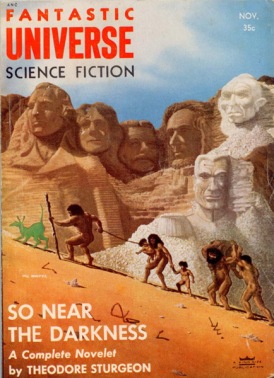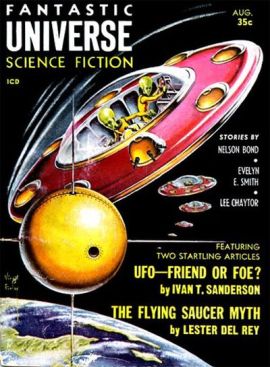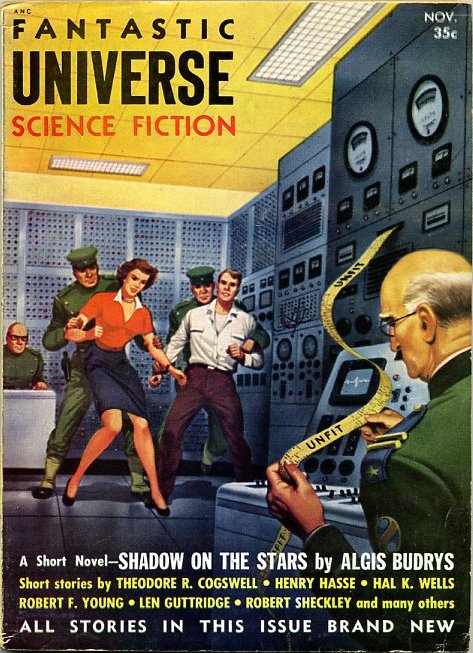
I think it’s time we recognize some other science fiction magazines besides Astounding Science Fiction. So I’ve picked Fantastic Universe on a whim. Below, I’m going to list all the issues of Fantastic Universe available to read online at the Internet Archive, but before that, I thought I might explain why. If this column works out, I might do additional magazines.
I’ve recently read four books about Astounding Science Fiction and its editor John W. Campbell, Jr. (Requiem for Astounding by Alva Rogers, The World Beyond the Hill by Alexei and Cory Panshin, Astounding Days by Arthur C. Clarke, and Astounding by Alec Nevala-Lee). Quite often when I read the history of science fiction magazines Hugo Gernsback gets credit for starting Amazing Stories, and John W. Campbell seemingly gets credit for almost everything else. Of course, that’s not true. Time and time again, writers want to write about Campbell and Astounding. I’d like to know about the other editors and their magazines.
 Most historians of the science fiction magazines do admit that Campbell’s influence waned in the 1950s as The Magazine of Fantasy and Science Fiction and Galaxy Science Fiction came on the scene. David L. Roshelm did write Galaxy Magazine: The Dark and the Light Years (1986), but as far as I know, no one has written a history of F&SF. There have been dozens of other science fiction magazines published in the 20th-century, and I have to wonder if their editors didn’t discover new writers, give new artists a gallery on their covers, provide letter columns for fans fighting their tempests in a teacup, and book reviewers a place to begin publishing.
Most historians of the science fiction magazines do admit that Campbell’s influence waned in the 1950s as The Magazine of Fantasy and Science Fiction and Galaxy Science Fiction came on the scene. David L. Roshelm did write Galaxy Magazine: The Dark and the Light Years (1986), but as far as I know, no one has written a history of F&SF. There have been dozens of other science fiction magazines published in the 20th-century, and I have to wonder if their editors didn’t discover new writers, give new artists a gallery on their covers, provide letter columns for fans fighting their tempests in a teacup, and book reviewers a place to begin publishing.
I collect anthologies of science fiction short stories. Most of the stories anthologized from the 1930s and 1940s have come from Astounding Science Fiction. And Astounding, F&SF, and Galaxy seem to dominate when looking at stories collected from the 1950s. Of course, these markets paid more, so their editors got the first look at work from the top writers. Yet, I’ve got to wonder about all those forgotten science fiction magazines, editors, and writers. Did their editors discover new writers? Have anthologists missed story gems from those forgotten magazines?
 The four books about Astounding break into two kinds. Rogers and Clarke were fans from the start and go back and review old issues story-by-story they fondly remember. The Panshins and Nevala-Lee were too young to have read Astounding growing up. The Panshins focused on analyzing the impact of stories, while Nevala-Lee focused on the biographies Campbell and his famous writers: Heinlein, Asimov, and Hubbard.
The four books about Astounding break into two kinds. Rogers and Clarke were fans from the start and go back and review old issues story-by-story they fondly remember. The Panshins and Nevala-Lee were too young to have read Astounding growing up. The Panshins focused on analyzing the impact of stories, while Nevala-Lee focused on the biographies Campbell and his famous writers: Heinlein, Asimov, and Hubbard.
Thus, historians of magazines can choose to write about the stories, writers, or editors, an sometimes about the cover artists, interior illustrators, and book reviewers. Alva Rogers had a collection of Astounding to work with, and Clarke was given a microfilm set of Astounding. Nevala-Lee had digital scans. Having access to old magazines makes writing about them easier.
Because of sites like the Internet Archive, researchers can now read many more old science fiction magazines. It’s a great time for genre scholars to pour through long forgotten issues looking for undiscovered discoveries regarding SF in the 1950s. Fantastic Universe got the reputation for supporting the UFO craze. Whether it’s editor and writers believed in flying saucers, or were trying to make a buck of the craze, is another issue. Ray Palmer at Amazing Stories and John W. Campbell, Jr. at Astounding both have piles of embarrassing editorials to defend too. And if you lived through the 1950s you’ll know people believed a lot of crazy ideas back then. Just read Confessions of a Crap Artist by Philip K. Dick, which I think is PKD’s best novel.
 I thought it would be fun to research a lesser known science fiction magazine and picked Fantastic Universe, which ran from 1953-1960. I did find Leo Margulies: Giant of the Pulps (2017) by Philip Sherman. Supposedly, in the 1930s Leo Margulies edited 46 different pulp titles, but he’s most famous among SF fans for editing Startling Stories and Thrilling Wonder Stories. Sam Merwin, Jr. also worked on those two pulps and others, but I could not find a biography devoted to him. Hans Stefan Santesson seems to have gotten his start with Fantastic Universe and then went on to edit The Saint Mystery Magazine from 1959-1967.
I thought it would be fun to research a lesser known science fiction magazine and picked Fantastic Universe, which ran from 1953-1960. I did find Leo Margulies: Giant of the Pulps (2017) by Philip Sherman. Supposedly, in the 1930s Leo Margulies edited 46 different pulp titles, but he’s most famous among SF fans for editing Startling Stories and Thrilling Wonder Stories. Sam Merwin, Jr. also worked on those two pulps and others, but I could not find a biography devoted to him. Hans Stefan Santesson seems to have gotten his start with Fantastic Universe and then went on to edit The Saint Mystery Magazine from 1959-1967.
Issue Lists (69)
Volume/Number links to ISFDB to see table of contents.
[IA] links to Internet Archive to read a scanned copy
1953 – Sam Merwin, Jr.
- Volume 1 Number 1 (June-July) [IA]
- Volume 1 Number 2 (August-September) [IA]
- Volume 1 Number 3 (October-November) [IA]
1954 – editor Beatrice Jones
- Volume 1 Number 4 (January) [IA]
- Volume 1 Number 5 (March) [IA]
1954 – editor Leo Margulies
- Volume 1 Number 6 (May) [IA]
- Volume 2 Number 1 (July) [IA]
- Volume 2 Number 2 (September) [IA]
- Volume 2 Number 3 (October) [IA]
- Volume 2 Number 4 (November)
- Volume 2 Number 5 (December)
1955 – editor Leo Margulies
- Volume 2 Number 6 (January) [IA]
- Volume 3 Number 1 (February)
- Volume 3 Number 2 (March)
- Volume 3 Number 3 (April) [IA]
- Volume 3 Number 4 (May)
- Volume 3 Number 5 (June) [IA]
- Volume 3 Number 6 (July) [IA]
- Volume 4 Number 1 (August) [IA]
- Volume 4 Number 2 (September) [IA]
- Volume 4 Number 3 (October) [IA]
- Volume 4 Number 4 (November) [IA]
- Volume 4 Number 5 (December) [IA]
1956 – editor Leo Margulies
- Volume 4 Number 6 (January) [IA]
- Volume 5 Number 1 (February) [IA]
- Volume 5 Number 2 (March) [IA]
- Volume 5 Number 3 (April) [IA]
- Volume 5 Number 4 (May) [IA]
- Volume 5 Number 5 (June) [IA]
- Volume 5 Number 6 (July) [IA]
- Volume 6 Number 1 (August) [IA]
1956 – editor Hans Stefan Santesson
- Volume 6 Number 2 (September) [IA]
- Volume 6 Number 3 (October) [IA]
- Volume 6 Number 4 (November) [IA]
- Volume 6 Number 5 (December) [IA]
1957 – editor Hans Stefan Santesson
- Volume 7 Number 1 (January) [IA]
- Volume 7 Number 2 (February) [IA]
- Volume 7 Number 3 (March) [IA]
- Volume 7 Number 4 (April) [IA]
- Volume 7 Number 5 (May) [IA]
- Volume 7 Number 6 (June) [IA]
- Volume 8 Number 1 (July) [IA]
- Volume 8 Number 2 (August) [IA]
- Volume 8 Number 3 (September) [IA]
- Volume 8 Number 4 (October)
- Volume 8 Number 5 (November) [IA]
- Volume 8 Number 6 (December) [IA]
1958 – editor Hans Stefan Santesson
- Volume 9 Number 1 (January) [IA]
- Volume 9 Number 2 (February) [IA]
- Volume 9 Number 3 (March) [IA]
- Volume 9 Number 4 (April) [IA]
- Volume 9 Number 5 (May)
- Volume 9 Number 6 (June)
- Volume 10 Number 1 (July) [IA]
- Volume 10 Number 2 (August) [IA]
- Volume 10 Number 3 (September)
- Volume 10 Number 4 (October)
- Volume 10 Number 5 (November) [IA]
1959 – editor Hans Stefan Santesson
- Volume 11 Number 1 (January) [IA]
- Volume 11 Number 2 (March) [IA]
- Volume 11 Number 3 (May) [IA]
- Volume 11 Number 4 (July) [IA]
- Volume 11 Number 5 (September) [IA]
- Volume 11 Number 6 (October) [IA]
- Volume 12 Number 1 (November)
- Volume 12 Number 2 (December)
1960 – editor Hans Stefan Santesson
- Volume 12 Number 3 (January)
- Volume 12 Number 4 (February) [IA]
- Volume 12 Number 5 (March) [IA]
The Internet Archive is becoming the Library of Congress for the web. It’s only missing 12 of the 69 issues of Fantastic Universe, and I’m pretty sure those issues will show up soon. I used to work in a periodicals department at a university and one of my jobs was tracking down and ordering missing issues. This was back in the 1980s and I had to snail-mail publishers all over the world. As our library ran out of space, we sometimes discarded whole runs of magazines, including a complete bound run of F&SF. That really killed my soul. I wanted them, but state law forbade the library from giving them to people, so they were shipped off to state surplus.
Now that libraries routinely discard items that seldom get used, it’s great that the Internet Archive is collecting everything it can as digital scans. Old pulp and digest magazines are aging badly, disintegrating and disappearing. So, scanning saves them for the future. And by being on the internet, people from all over the world can use them to write about the history of science fiction.
In the future, I’m hoping to see more books like Astounding by Alec Nevala-Lee about other areas of science fiction history. I was surprised by how many prominent general interest magazines reviewed it. I assume there are many more old fans like me who want to read about the evolution of science in magazines.
Additional Reading:
- Issue grid with covers
- Entry at The Encyclopedia of Science Fiction
- Entry at LibraryThing
- Pulpcovers
James Wallace Harris, 2/1/19

Another fantastic article, Jim!
The Eureka Years, by Annette McComas, is the nearest thing to a history of the Magazine of Fantasy & Science Fiction that I know of. I’ve never seen it, but I came across it while looking for something else.
By the way, does anyone know which of today’s publications pays the best rates for short fiction? I have a theory that a good way to find excellent short fiction is to follow the money.
LikeLike
I went and snagged a copy of The Eureka Years. It seems mostly an anthology of short stories, but I hope it has enough essays to give a sense of history. Thanks.
LikeLike
Are some of those missing issues due to better known authors maintaining copyright? (or more likely their descendants). For example, although some New Worlds magazines are on Internet Archives sometimes specifics stories are excised! Which is really frustrating…. (Ballard’s for example)
LikeLike
Some authors protested when the pulp scans started going up, and there’s still a process for requesting removal at Internet Archive, but I think for the most part they’ve given up on magazines.
LikeLike
As I mentioned, I don’t think they’ve given up when it comes to New World magazines… especially from the 60s/70s. I wanted to see the original art and the stories would be cut… alas.
LikeLike
I’ll start keeping at an eye out for missing stories. I’ve been thinking of collecting New Worlds.
LikeLike
Hi James
A great idea. I know from reading Alec Nevala-Lee that Campbell refused Bradbury’s The Million Year Picnic and Mars is Heaven, which then both appeared in Planet Stories which I assume was a lesser market. They then became part of the Martian Chronicles which is still considered a significant book, where a lot of Campbell’s other selections are almost forgotten by the genre. Since you are interested in the editors, my wife gave me The Man From Mars Ray Palmer’s Amazing Pulp Journey by Fred Nadis which is a really interesting read. I have always been interested in The Shaver Mystery and Fortean elements in science fiction and Palmer was central to both for good or ill. Weird Tales also published a number of science fiction authors, Hamilton and Bradbury for example and Arkham House, the publisher most associated with it also published Slan by Van Vogt in 1946 and books by Greg Bear, James Tiptree Jr, J.G. Ballard so science fiction is as you said more that Gernsback and Campbell, Astounding, Amazing and Galaxy etc.
All the best
Guy
LikeLike
The Eureka Years contains letters between editors and writers and plenty of commentary. It’s well worth reading. Anthologists missed great stories in magazines such as Fantastic Universe, Raymond F. Jones being a case in point. Cele Goldsmith published new talent during her editorship of Amazing and Fantastic.
LikeLike
I just bought a Raymond F. Jones story yesterday, The Year When Stardust Fell. I got it on audio and Kindle. I remember discovering Jones from reading his Winston Science Fiction juveniles. By the way, those Winston juveniles are being reprinted today.
LikeLike
Hi James
Great news about the Winston Science Fiction series, the originals are really expensive, due I guess to the nostalgia value. I look forward to getting some. Danger Dinosaurs has always beckoned. The Year When Star Dust Fell is another title I really would like.
Thanks Guy
LikeLike
If you buy the 99 cent ebook of The Year When Star Dust Fell you can get the Audible edition for $2.99. Unfortunately, this ebook isn’t one of the reprints that use the original cover art.
LikeLike